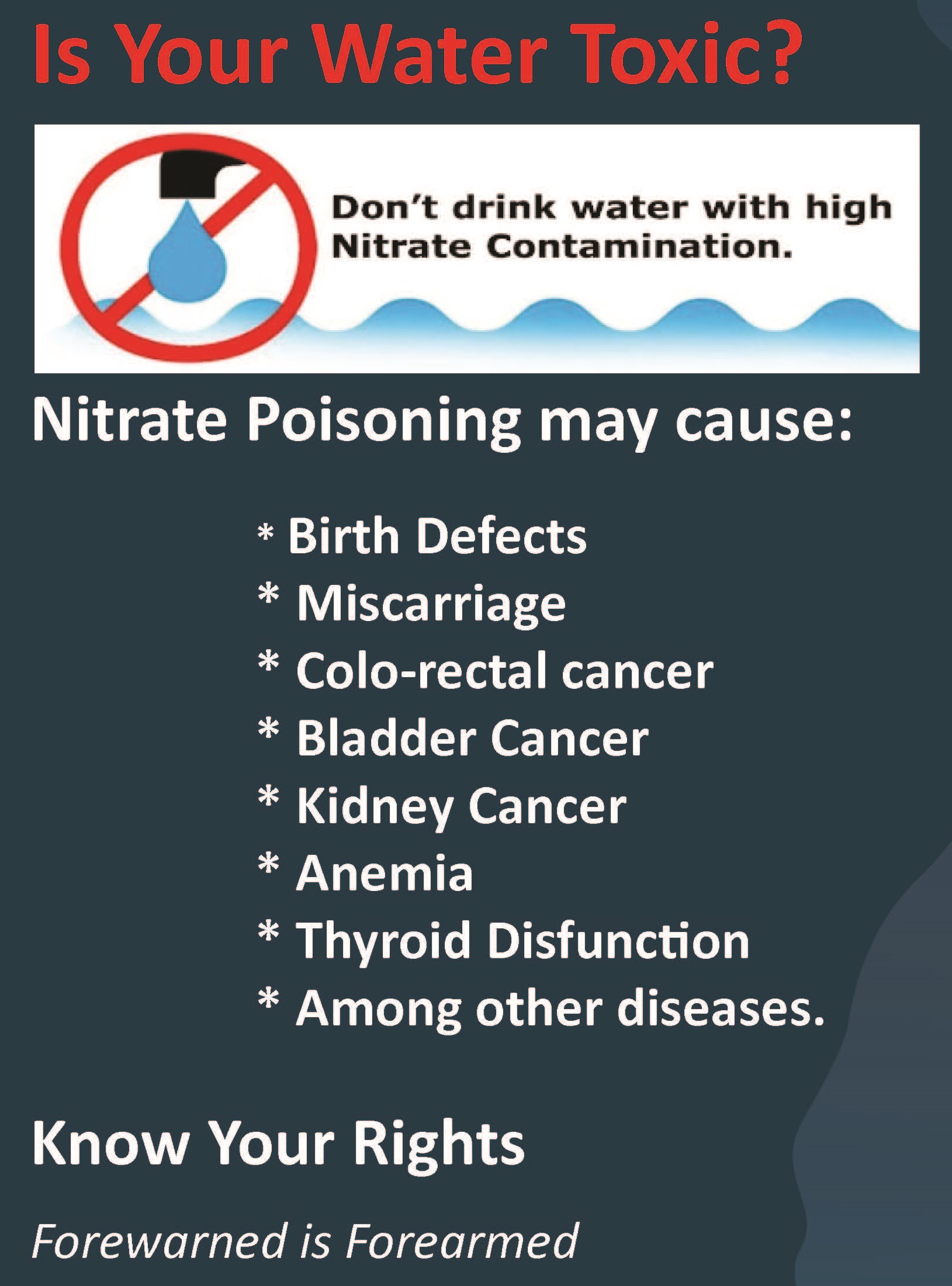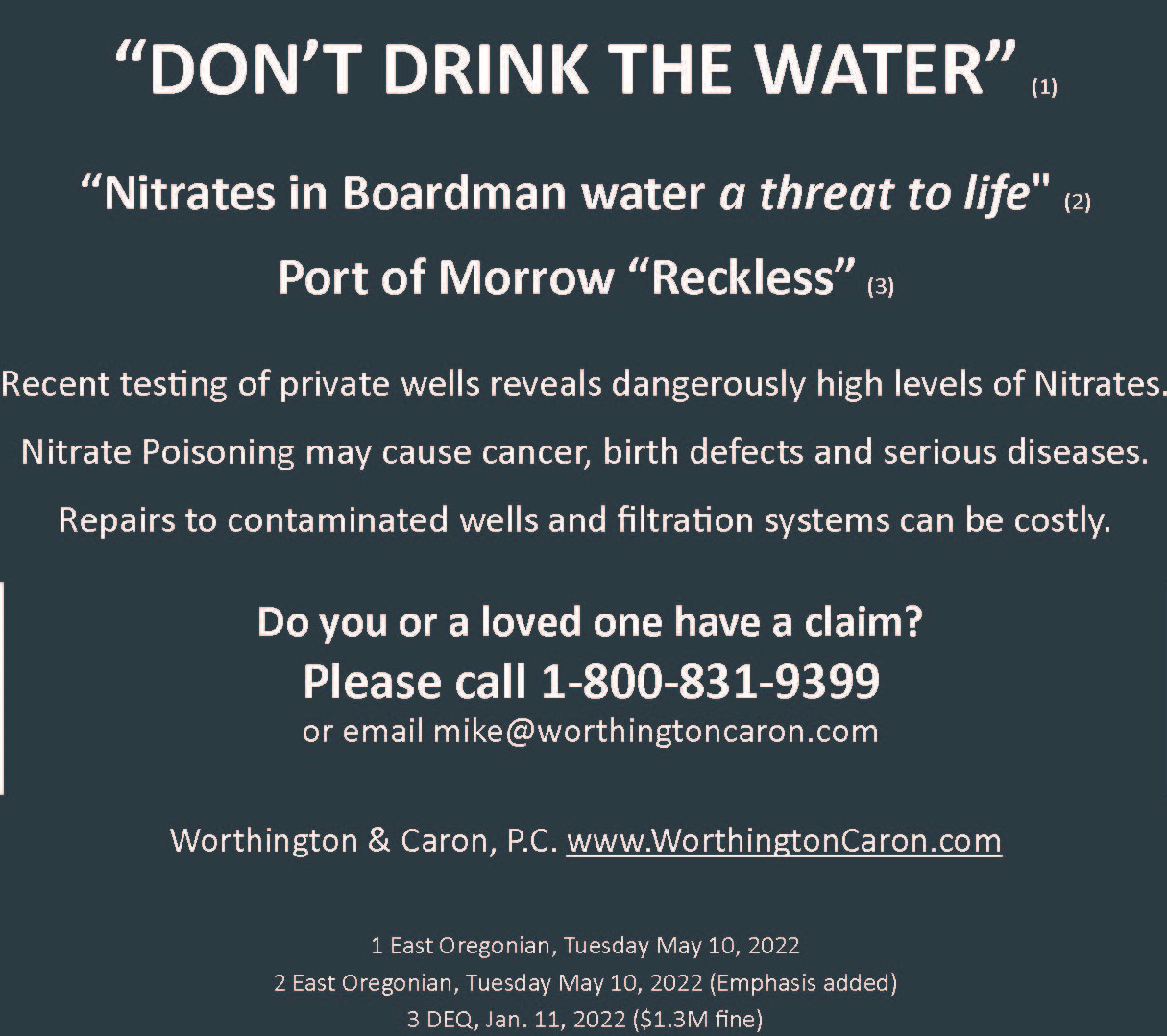
Nitrates in Groundwater
What Are the Health Effects from Exposure to Nitrates and Nitrites?
- What Are the Health Effects from Exposure to Nitrates and Nitrites?
- Nitrate/Nitrite Toxicity - Case Studies in Environmental Medicine
- What Instructions should Be Given to Patients to Prevent Overexposure to Nitrates and Nitrites?
- Nitrates/Nitrites Poisoning Patient Education Care Instruction Sheet
- Nitrates/Nitrites Toxic Facts
-----------------------------------------------------
Nitrate and nitrite contamination in drinking water and cancer risk: A systematic review with meta-analysis
Environmental Research - July 2022
Background: Pollution of water sources, largely from wide-scale agricultural fertilizer use has resulted in nitrate and nitrite contamination of drinking water. The effects on human health of raised nitrate and nitrite levels in drinking water are currently unclear.
Conclusions: We identified an association of nitrate in drinking water with gastric cancer but with no other cancer site. There is currently a paucity of robust studies from settings with high levels nitrate pollution in drinking water. Research into this area will be valuable to ascertain the true health burden of nitrate contamination of water and the need for public policies to protect human health.
------------------------------------------------------
Examining Relationships Between Groundwater Nitrate Concentrations in Drinking Water and Landscape Characteristics to Understand Health Risks
GeoHelalth - May 2022
Abstract Nitrate ingested from drinking water has been linked to adverse health outcomes (e.g., cancer, birth defects) at levels as low as 2 mg/L NO3-N, far below the regulatory limits of 10 mg/L. In many areas, groundwater is a common drinking water source and may contain elevated nitrate, but limited data on the patterns and concentrations are available. Using an extensive regulatory data set of over 100,000 nitrate drinking water well samples, we developed new maps of groundwater nitrate concentrations from 76,724 wells in Michigan's Lower Peninsula, USA for the 2006-2015 period. Kriging, a geostatistical method, was used to interpolate concentrations and quantify probability of exceeding relevant thresholds (>0.4 [common detection limit], >2 mg/L NO3-N). We summarized this probability in small watersheds (∼80 km2) to identify correlated variables using the machine learning method classification and regression trees (CARTs).
------------------------------------------------------
Supplementation with dietary omega-3 PUFA mitigates fetal brain inflammation and mitochondrial damage caused by high doses of sodium nitrite in maternal rats
PLOS One - March 2022
Objective: Food safety and nutrition during pregnancy are important concerns related to fetal brain development. In the present study, we aimed to explore the effects of omega-3 polyunsaturated fatty acids (PUFA ω-3) on exogenous sodium nitrite intervention-induced fetal brain injury in pregnant rats.
Conclusions: Sodium nitrite exposure during pregnancy could cause brain damage in fetal rats. PUFA ω-3 might help alleviate brain inflammation, oxidative stress, and mitochondrial damage, possibly through the NRF1/HMOX1 signaling pathway. In conclusion, appropriately reducing sodium nitrite exposure and increasing PUFA omega-3 intake during pregnancy may benefit fetal brain development. These findings could further our understanding of nutrition and health during pregnancy.
------------------------------------------------------
Nitrate in Drinking Water during Pregnancy and Spontaneous Preterm Birth: A Retrospective Within-Mother Analysis in California
Environmental HealthPerspectives - May 2021
Background: Nitrate is a widespread groundwater contaminant and a leading cause of drinking water quality violations in California. Associations between nitrate exposure and select adverse birth outcomes have been suggested, but few studies have examined gestational exposures to nitrate and risk of preterm birth (before 37 wk gestation).
Discussion: The results suggest that nitrate in drinking water is associated with increased odds of spontaneous preterm birth. Notably, we estimated modestly increased odds associated with tap water nitrate concentrations of 5 to <10mg/L<10mg/L (below the federal drinking water standard of 10mg/L10mg/L) relative to <5mg/L<5mg/L. .
------------------------------------------------------
Drinking-water nitrate and cancer risk: A systematic review and meta-analysis
Archives of Environmental & Occupational Health - November 2020
Background: Nitrate is an inorganic compound that occurs naturally in all surface and groundwater, although higher concentrations tend to occur only where fertilizers are used on the land. The regulatory limit for nitrate in public drinking water supplies was set to protect against infant methemoglobinemia, but other health effects were not considered. Risk of specific cancers and congenital disabilities may be increased when the nitrate is ingested, and nitrate is reduced to nitrite, which can react with amines and amides by nitrosation to form N-nitroso compounds which are known animal carcinogens.
Conclusion: This study showed that there is an association between the intake of nitrate from drinking water and a type of cancer in humans. The effective way of controlling nitrate concentrations in drinking water is the prevention of contamination (water pollution). Further research work on this topic is needed.
------------------------------------------------------
High levels of nitrate in drinking water can affect everyone.
Wisconsin Department of Health Services (2019)
Protect yourself and your family by testing your well every year for nitrate and finding a safe source of water if levels are high.
------------------------------------------------------
Prenatal exposure to nitrate in drinking water and the risk of congenital anomalies
Environmental Research - September 2019
Background: Nitrate is a common water contaminant that has been associated with birth defects, although the evidence is limited. The purpose of this study was to examine whether maternal consumption of nitrate through drinking water is associated with an increased risk of congenital anomalies.
Conclusion: The positive associations found between nitrate exposure via drinking water and congenital abnormalities are largely consistent with some previous epidemiologic studies. The results of this study should be interpreted with caution given limitations in our ability to estimate exposures and the lack information on some risk factors for congenital abnormalities. Our findings may have serious policy implications given that exposure levels in our study were well below current EPA standards for nitrate in drinking water.
------------------------------------------------------
Drinking Water Nitrate and Human Health: An Updated Review
By: Mary H. Ward, Rena R. Jones, et al - May 17, 2018
International Journal of Environmental Research and Public Health
Abstract: Nitrate levels in our water resources have increased in many areas of the world largely due to applications of inorganic fertilizer and animal manure in agricultural areas. The regulatory limit for nitrate in public drinking water supplies was set to protect against infant methemoglobinemia, but other health effects were not considered.
Keywords: drinking water; nitrate; cancer; adverse reproductive outcomes; methemoglobinemia; thyroid disease; endogenous nitrosation; N-nitroso compounds
------------------------------------------------------
Consumer Factsheet on Nitrates/Nitrites
National Service Center for Environmental Publications (NSCEP) - 2014
- What are Nitrates/Nitrites and how are they used?
- Why are Nitrates/Nitrites being regulated?
- What are the health effects
------------------------------------------------------
When does nitrate become a risk for humans?
Journal of Environmental Quality - February 2008
Abstract Is nitrate harmful to humans? Are the current limits for nitrate concentration in drinking water justified by science? There is substantial disagreement among scientists over the interpretation of evidence on the issue. There are two main health issues: the linkage between nitrate and (i) infant methaemoglobinaemia, also known as blue baby syndrome, and (ii) cancers of the digestive tract. The evidence for nitrate as a cause of these serious diseases remains controversial.
------------------------------------------------------
Nitrates and Nitrites
Teach Chemical Summary - Last revised May 2007
Nitrates and nitrites are chemicals used in fertilizers, in rodenticides (to kill rodents), and as food preservatives. Nitrates and nitrites come in various forms, but when dried are typically a white or crystalline powder. Nitrate (NO3 - ) and nitrite (NO2 - ) are also naturally-occurring compounds that are a metabolic product of microbial digestion of wastes containing nitrogen, for example, animal feces or nitrogen-based fertilizers.
------------------------------------------------------
A review of nitrates in drinking water: maternal exposure and adverse reproductive and developmental outcomes
Environmental Health Perspectives - March 2006
Abstract In this review we present an update on maternal exposure to nitrates in drinking water in relation to possible adverse reproductive and developmental effects, and also discuss nitrates in drinking water in the United States. The current standard for nitrates in drinking water is based on retrospective studies and approximates a level that protects infants from methemoglobinemia, but no safety factor is built into the standard. The current standard applies only to public water systems. Drinking water source was related to nitrate exposure (i.e., private systems water was more likely than community system water to have nitrate levels above the maximum contaminant limit). Animal studies have found adverse reproductive effects resulting from higher doses of nitrate or nitrite.
------------------------------------------------------

Our Mission
-
Medical Empowerment
Get the information you need to make informed decisions about your treatment.
-
Legal Empowerment
Get the compensation you need to address the financial cost of your illness.
-
Going For The Gold
Helping empower our clients with over $2.5 Billion in recoveries. We fight for our clients!
-
Giving Back To The Community
Unprecedented Support for Mesothelioma Research. See how we can help!





